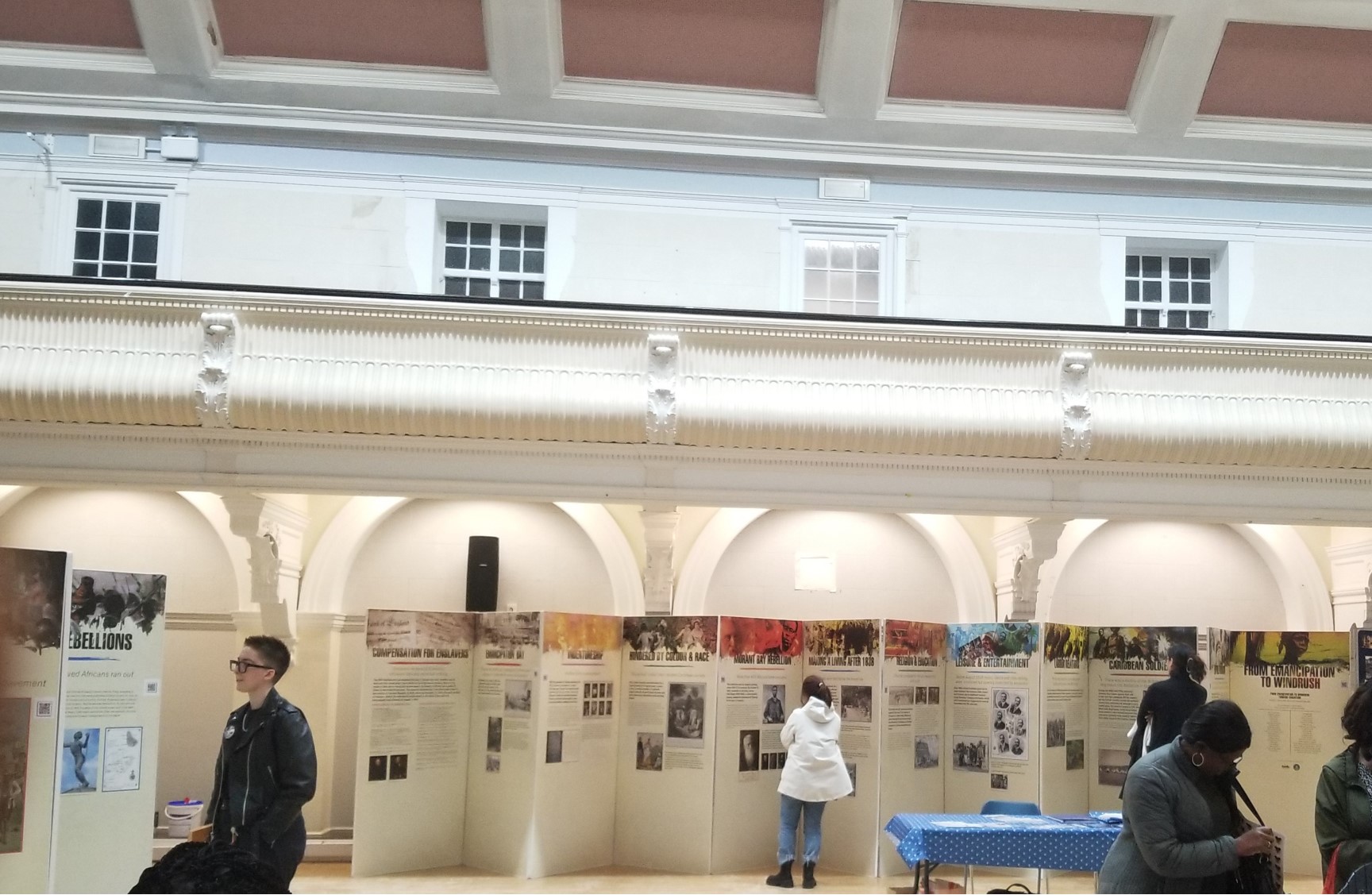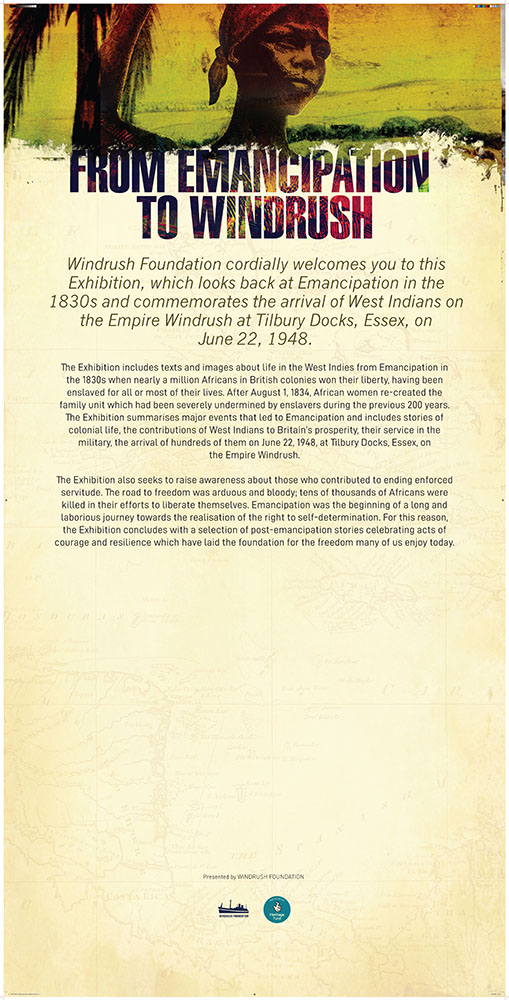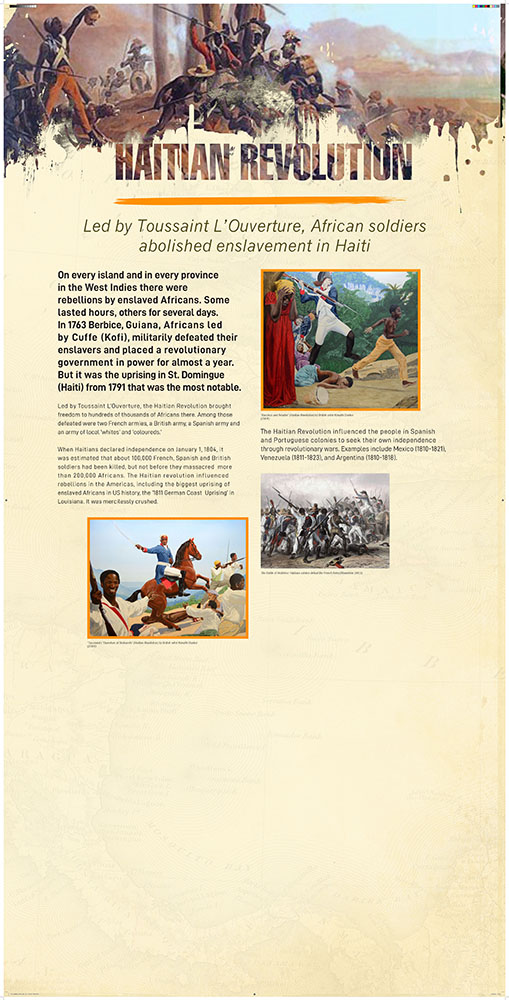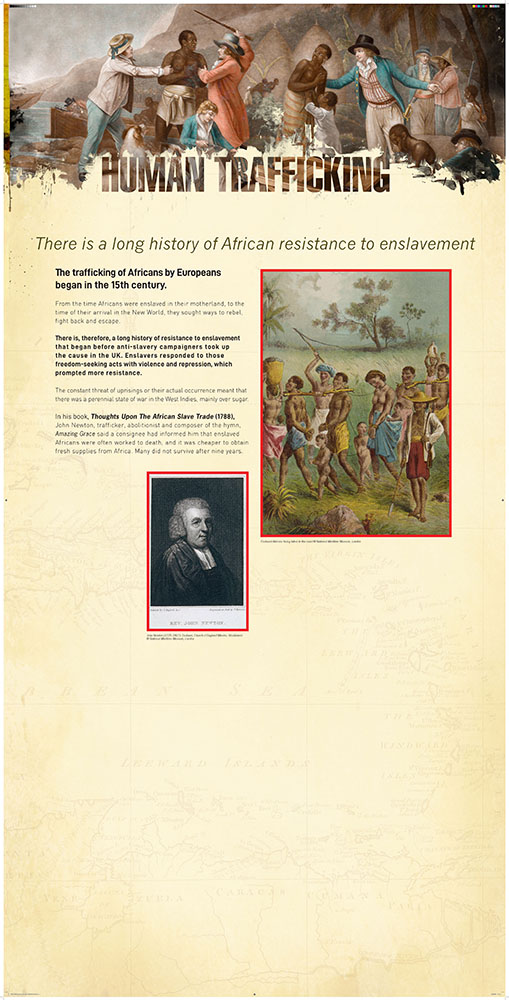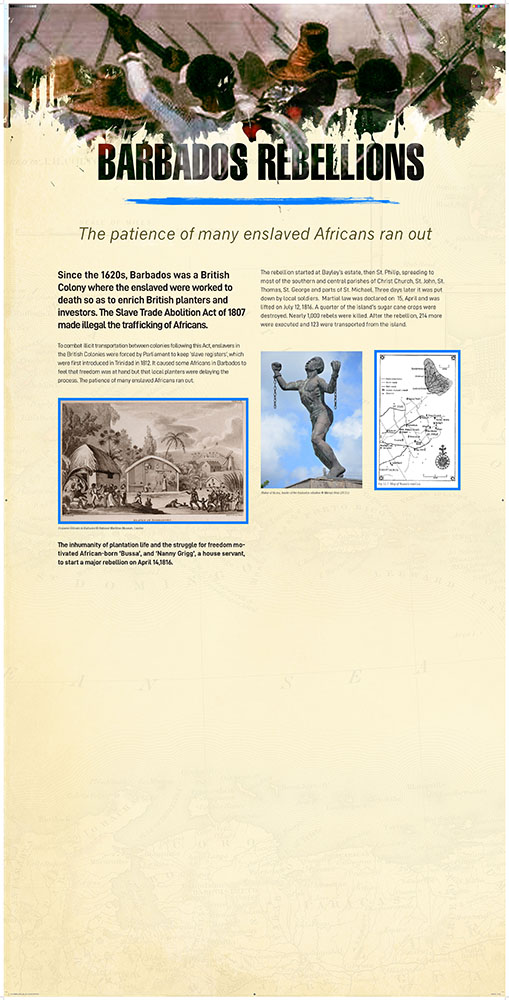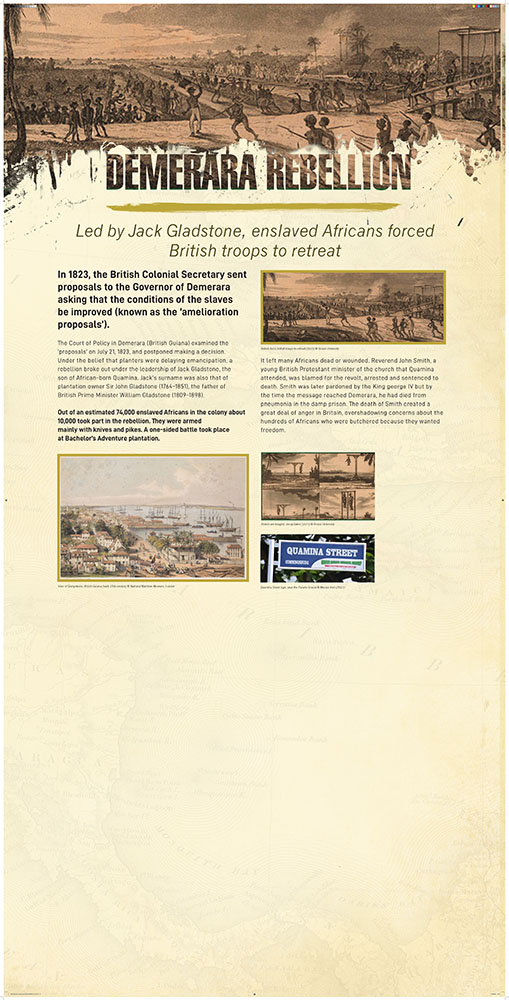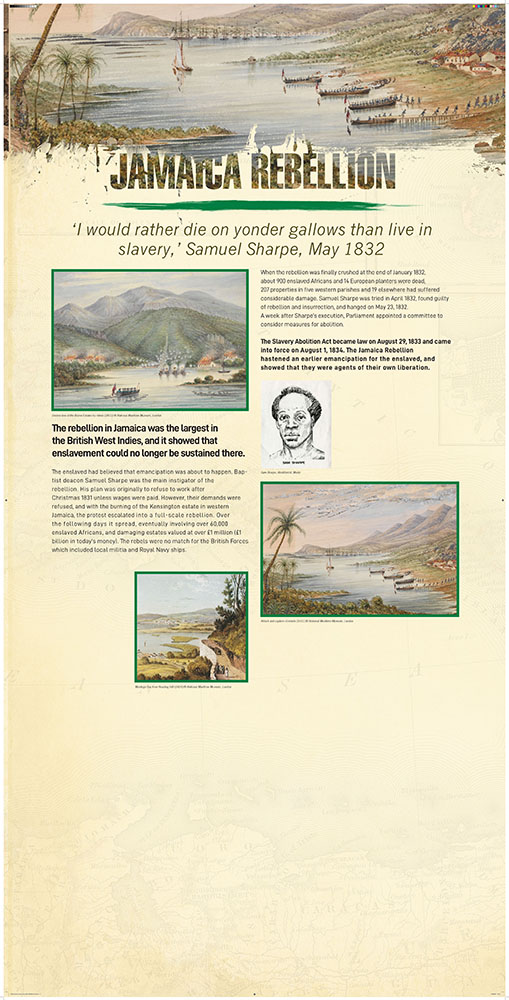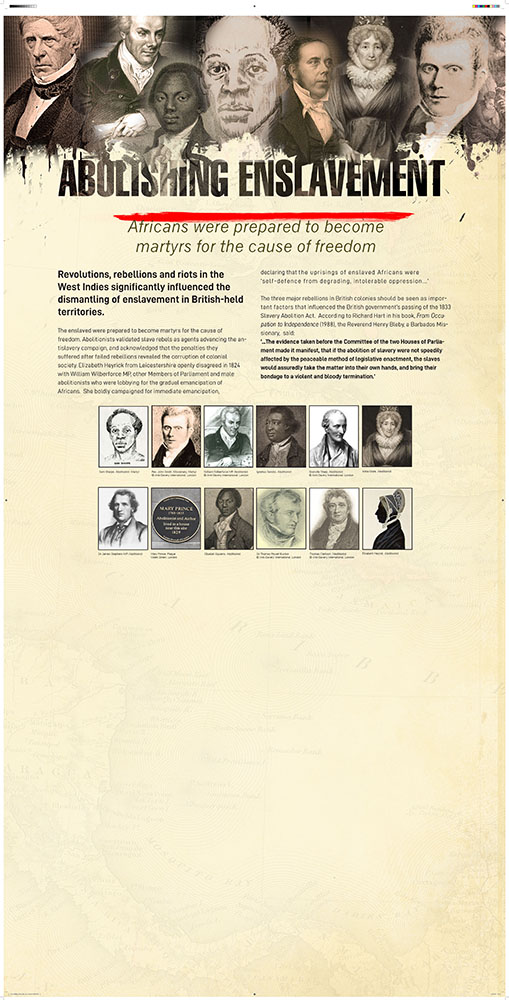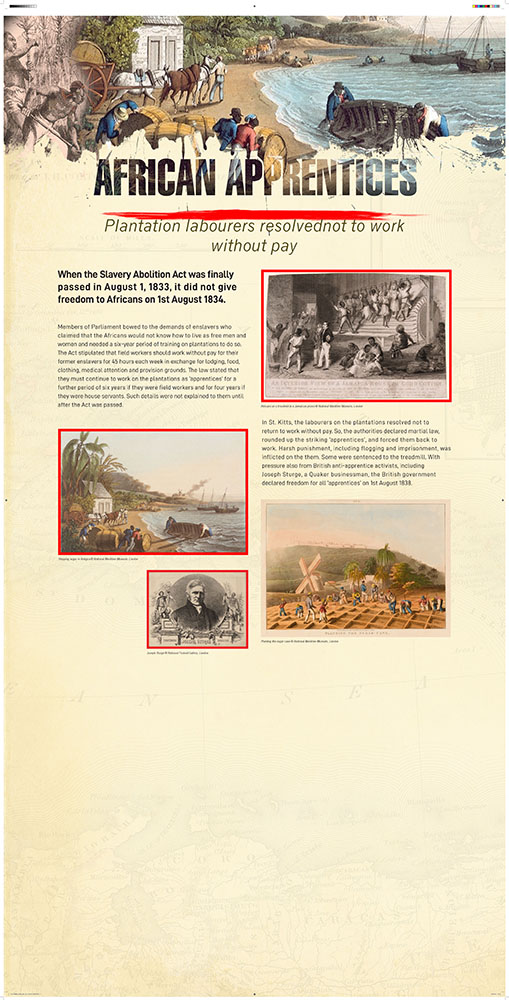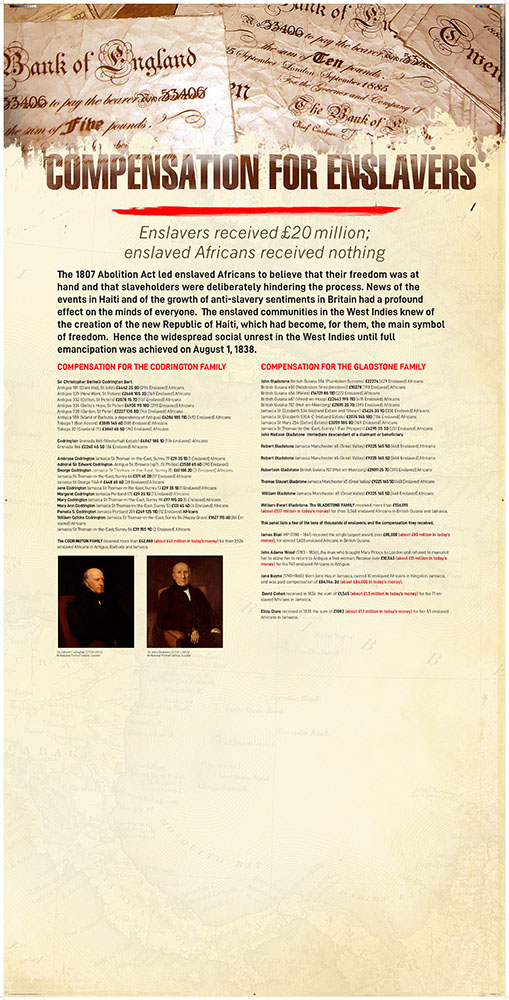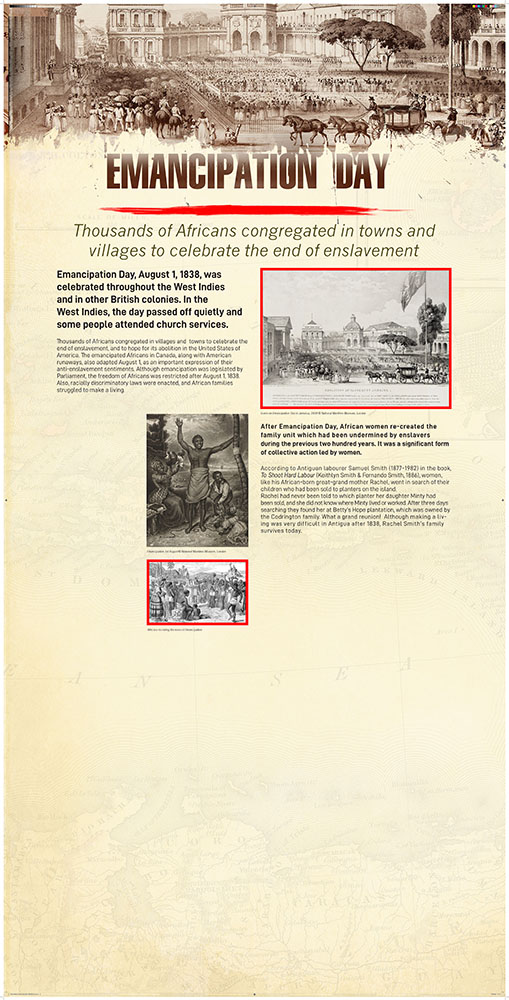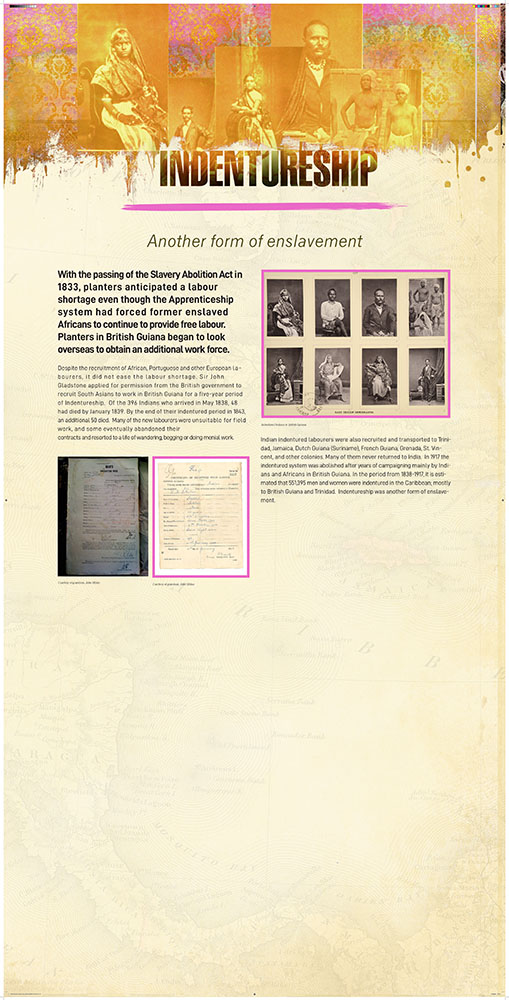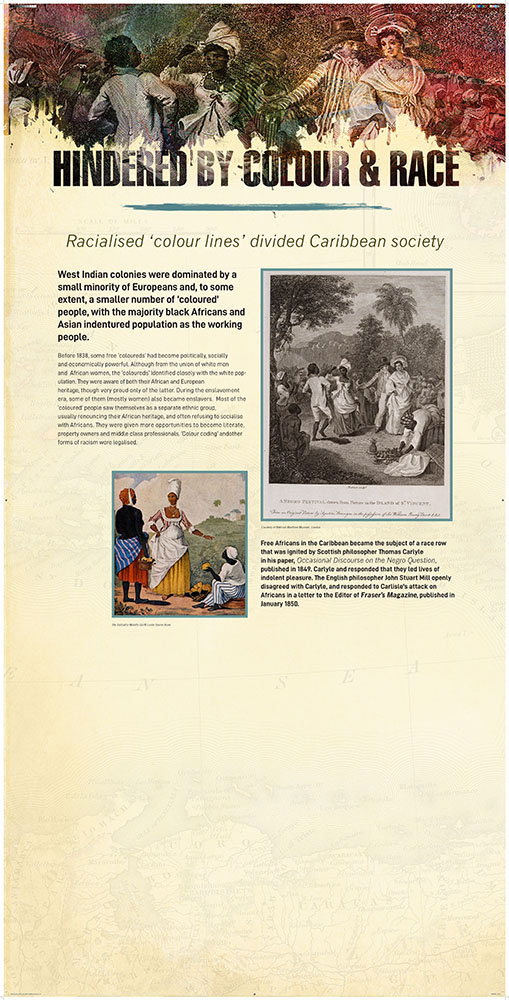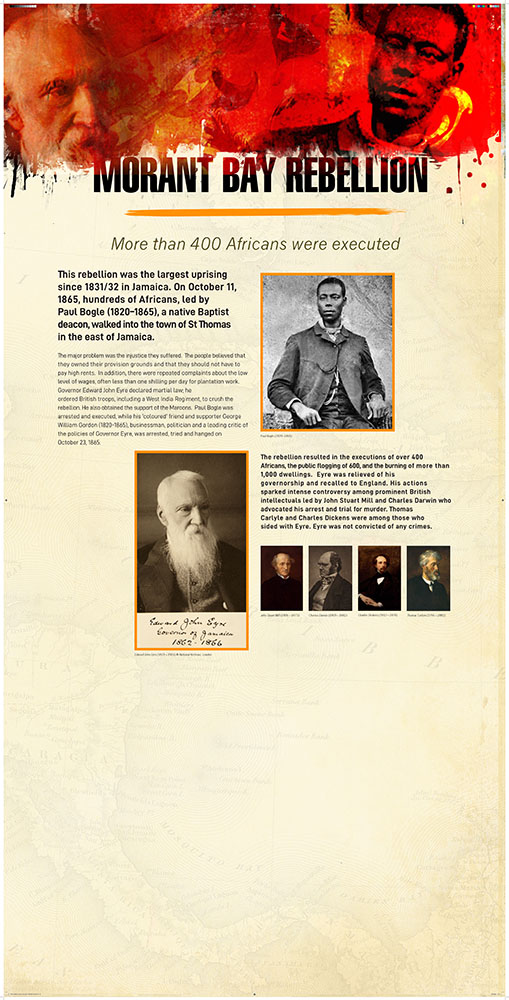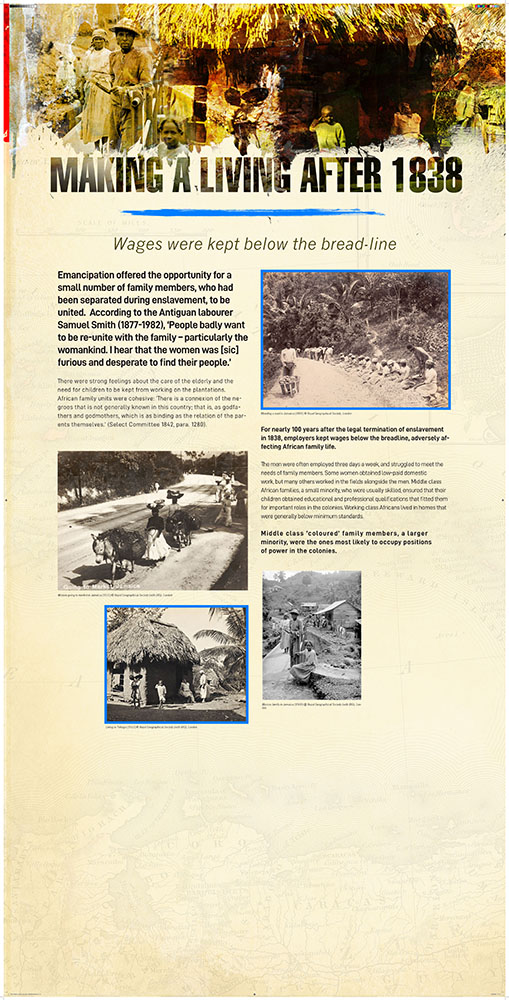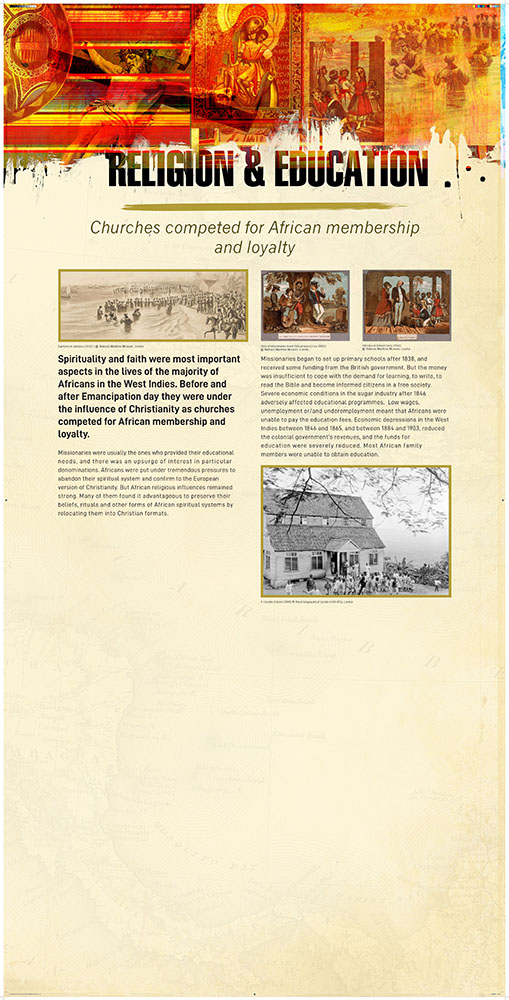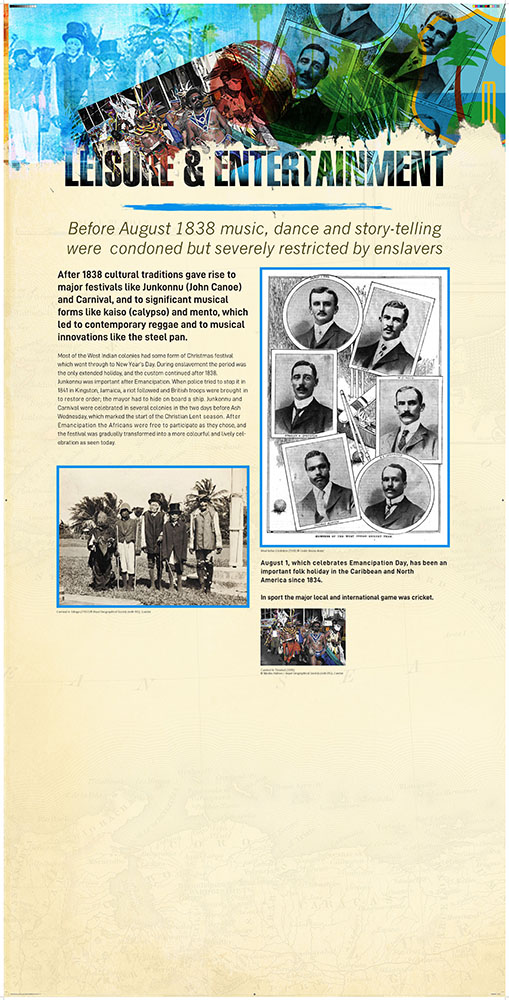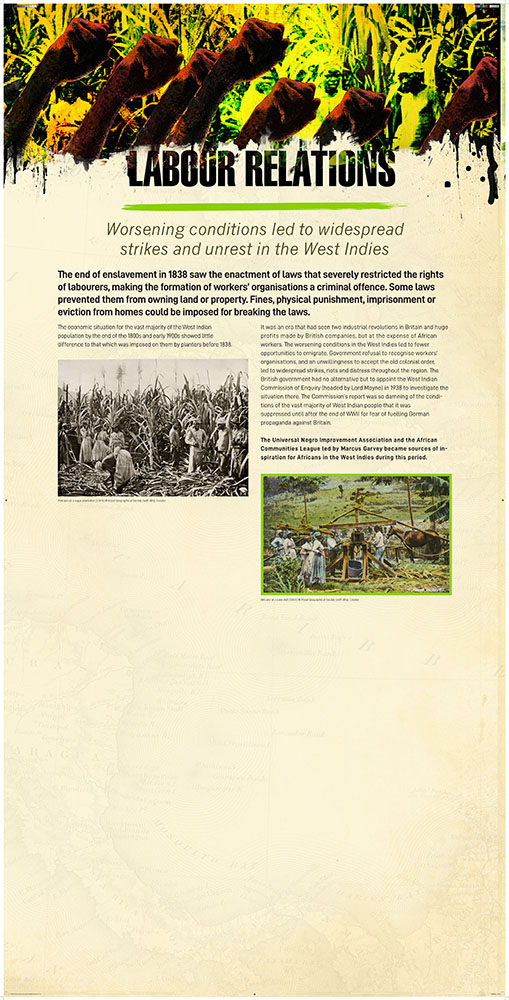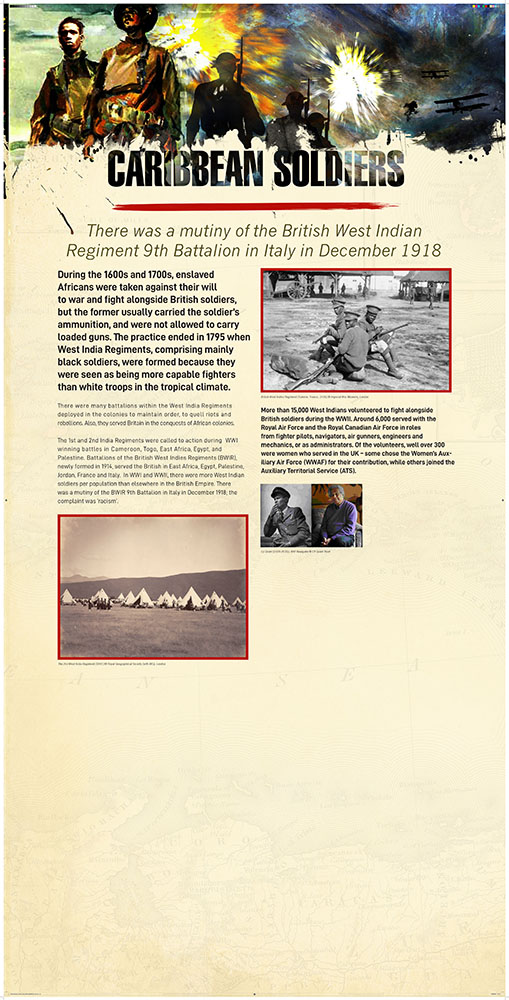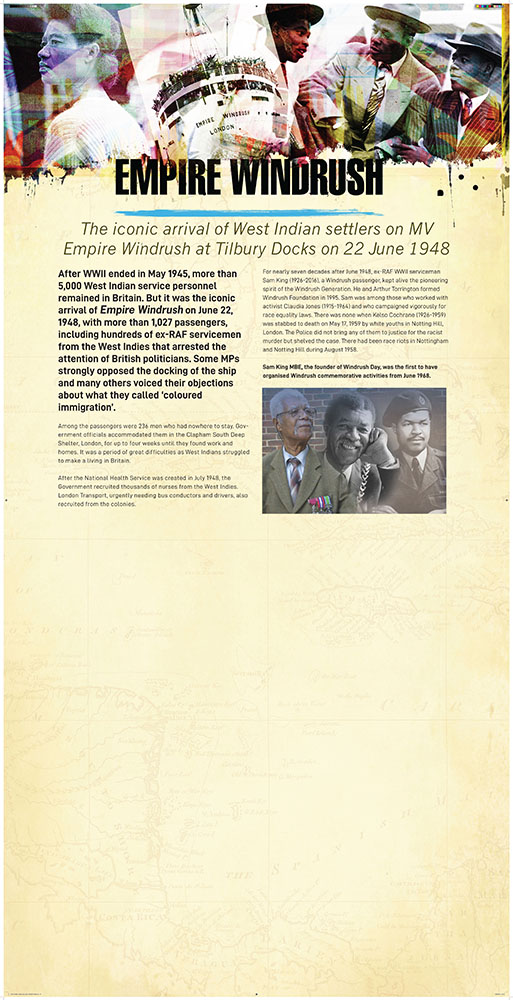From Emancipation to Windrush Exhibition
Touring Exhibition from 2023
The Exhibition includes texts and images about life in the West Indies from Emancipation in the 1830s when nearly a million Africans in British colonies won their liberty, having been enslaved for all or most of their lives. After August 1, 1834, African women re-created the family unit which had been severely undermined by enslavers during the previous 200 years. The Exhibition summarises major events that led to Emancipation and includes stories of colonial life, the contributions of West Indians to Britain’s prosperity, their service in the military, the arrival of hundreds of them on June 22, 1948, at Tilbury Docks, Essex, on the Empire Windrush.
The Exhibition also seeks to raise awareness about those who contributed to ending enforced servitude. The road to freedom was arduous and bloody; tens of thousands of Africans were killed in their efforts to liberate themselves. Emancipation was the beginning of a long and laborious journey towards the realisation of the right to self-determination. For this reason, the Exhibition concludes with a selection of post-emancipation stories celebrating acts of courage and resilience which have laid the foundation for the freedom many of us enjoy today.
Haitian Revolution
Led by Toussaint Louverture, African soldiers abolished enslavement in Haiti.
On every island and in every province in the West Indies there were rebellions by enslaved Africans. Some lasted hours, others for several days. In 1763 Berbice, Guiana, Africans led by Cuffe (Kofi), militarily defeated their enslavers and placed a revolutionary government in power for almost a year. But it was the uprising in St. Domingue (Haiti) from 1791 that was the most notable.
Led by Toussaint L’Ouverture, the Haitian Revolution brought freedom to hundreds of thousands of Africans there. Among those defeated were two French armies, a British army, a Spanish army and an army of local ‘whites’ and ‘coloureds.’
When Haitians declared independence on January 1, 1804, it was estimated that about 100,000 French, Spanish and British soldiers had been killed, but not before they massacred more than 200,000 Africans. The Haitian revolution influenced rebellions in the Americas, including the biggest uprising of enslaved Africans in US history, the ‘1811 German Coast Uprising’ in Louisiana. It was mercilessly crushed.
The Haitian Revolution influenced the people in Spanish and Portuguese colonies to seek their own independence through revolutionary wars. Examples include Mexico (1810-1821), Venezuela (1811-1823), and Argentina (1810-1818).
Human Trafficking
There is a long history of African resistance to enslavement.
The trafficking of Africans by Europeans began in the 15th century.
From the time Africans were enslaved in their motherland, to the time of their arrival in the New World, they sought ways to rebel, fight back and escape.
There is, therefore, a long history of resistance to enslavement that began before anti-slavery campaigners took up the cause in the UK. Enslavers responded to those freedom-seeking acts with violence and repression, which prompted more resistance. The constant threat of uprisings or their actual occurrence meant that there was a perennial state of war in the West Indies, mainly over sugar.
In his book, Thoughts Upon The African Slave Trade (1788), John Newton, trafficker, abolitionist and composer of the hymn, Amazing Grace said a consignee had informed him that enslaved Africans were often worked to death, and it was cheaper to obtain fresh supplies from Africa. Many did not survive after nine years.
Barbados Rebellion
The patience of many enslaved Africans ran out.
Since the 1620s, Barbados was a British Colony where the enslaved were worked to death so as to enrich British planters and investors. The Slave Trade Abolition Act of 1807 made illegal the trafficking of Africans.
To combat illicit transportation between colonies following this Act, enslavers in the British Colonies were forced by Parliament to keep ‘slave registers’, which were first introduced in Trinidad in 1812. It caused some Africans in Barbados to feel that freedom was at hand but that local planters were delaying the process. The patience of many enslaved Africans ran out.
The rebellion started at Bayley’s estate, then St. Philip, spreading to most of the southern and central parishes of Christ Church, St. John, St. Thomas, St. George and parts of St. Michael. Three days later it was put down by local soldiers. Martial law was declared on 15, April and was lifted on July 12, 1816. A quarter of the island’s sugar cane crops were destroyed. Nearly 1,000 rebels were killed. After the rebellion, 214 more were executed and 123 were transported from the island.
Demerara Rebellion
Led by Jack Gladstone, enslaved Africans forced British troops to retreat.
In 1823, the British Colonial Secretary sent proposals to the Governor of Demerara asking that the conditions of the slaves be improved (known as the ‘amelioration proposals’).
The Court of Policy in Demerara (British Guiana) examined the ‘proposals’ on July 21, 1823, and postponed making a decision. Under the belief that planters were delaying emancipation, a rebellion broke out under the leadership of Jack Gladstone, the son of African-born Quamina. Jack’s surname was also that of plantation owner Sir John Gladstone (1764–1851), the father of British Prime Minister William Gladstone (1809–1898).
Out of an estimated 74,000 enslaved Africans in the colony about 10,000 took part in the rebellion. They were armed mainly with knives and pikes. A one-sided battle took place at Bachelor’s Adventure plantation.
It left many Africans dead or wounded. Reverend John Smith, a young British Protestant minister of the church that Quamina attended, was blamed for the revolt, arrested and sentenced to death. Smith was later pardoned by the King George IV but by the time the message reached Demerara, he had died from pneumonia in the damp prison. The death of Smith created a great deal of anger in Britain, overshadowing concerns about the hundreds of Africans who were butchered because they wanted freedom
Jamaica Rebellion
‘I would rather die on yonder gallows than live in slavery,’ Samuel Sharpe, May 1832
The rebellion in Jamaica was the largest in the British West Indies, and it showed that enslavement could no longer be sustained there. The enslaved had believed that emancipation was about to happen. Baptist deacon Samuel Sharpe was the main instigator of the rebellion. His plan was originally to refuse to work after Christmas 1831 unless wages were paid. However, their demands were refused, and with the burning of the Kensington estate in western Jamaica, the protest escalated into a full-scale rebellion. Over the following days it spread, eventually involving over 60,000 enslaved Africans, and damaging estates valued at over £1 million (£1 billion in today’s money). The rebels were no match for the British Forces which included local militia and Royal Navy ships.
When the rebellion was finally crushed at the end of January 1832, about 900 enslaved Africans and 14 European planters were dead, 207 properties in five western parishes and 19 elsewhere had suffered considerable damage. Samuel Sharpe was tried in April 1832, found guilty of rebellion and insurrection, and hanged on May 23, 1832. A week after Sharpe’s execution, Parliament appointed a committee to consider measures for abolition.
The Slavery Abolition Act became law on August 29, 1833, and came into force on August 1, 1834. The Jamaica Rebellion hastened an earlier emancipation for the enslaved, and showed that they were agents of their own liberation.
Abolishing Enslavement
Africans were prepared to become martyrs for the cause of freedom.
Revolutions, rebellions and riots in the West Indies significantly influenced the dismantling of enslavement in British-held territories. The enslaved were prepared to become martyrs for the cause of freedom. Abolitionists validated slave rebels as agents advancing the anti-slavery campaign, and acknowledged that the penalties they suffered after failed rebellions revealed the corruption of colonial society. Elizabeth Heyrick from Leicestershire openly disagreed in 1824 with William Wilberforce MP, other Members of Parliament and male abolitionists who were lobbying for the gradual emancipation of Africans. She boldly campaigned for immediate emancipation, declaring that the uprisings of enslaved Africans were ‘self-defence from degrading, intolerable oppression…’
The three major rebellions in British colonies should be seen as important factors that influenced the British government’s passing of the 1833 Slavery Abolition Act. According to Richard Hart in his book, From Occupation to Independence (1988), the Reverend Henry Bleby, a Barbados Missionary, said: ‘…The evidence taken before the Committee of the two Houses of Parliament made it manifest, that if the abolition of slavery were not speedily affected by the peaceable method of legislative enactment, the slaves would assuredly take the matter into their own hands, and bring their bondage to a violent and bloody termination.’
African Apprentices
Plantation labourers resolved not to work without pay.
When the Slavery Abolition Act was finally passed on August 1, 1833, it did not give freedom to Africans on 1st August 1834.
Members of Parliament bowed to the demands of enslavers who claimed that the Africans would not know how to live as free men and women and needed a six-year period of training on plantations to do so. The Act stipulated that field workers should work without pay for their former enslavers for 45 hours each week in exchange for lodging, food, clothing, medical attention, and provision grounds. The law stated that they must continue to work on the plantations as ‘apprentices’ for a further period of six years if they were field workers and for four years if they were house servants. Such details were not explained to them until after the Act was passed.
In St. Kitts, the labourers on the plantations resolved not to return to work without pay. So, the authorities declared martial law, rounded up the striking ‘apprentices’, and forced them back to work. Harsh punishment, including flogging and imprisonment, was inflicted on them. Some were sentenced to the treadmill. With pressure also from British anti-apprentice activists, including Joseph Sturge, a Quaker businessman, the British government declared freedom for all ‘apprentices’ on 1st August 1838.
Compensation For Enslavers
Enslavers received £20million; enslaved Africans received nothing.
The 1807 Abolition Act led enslaved Africans to believe that their freedom was at hand and that slaveholders were deliberately hindering the process. News of the events in Haiti and of the growth of anti-slavery sentiments in Britain had a profound effect on the minds of everyone. The enslaved communities in the West Indies knew of the creation of the new Republic of Haiti, which had become, for them, the main symbol of freedom. Hence the widespread social unrest in the West Indies until full emancipation was achieved on August 1, 1838.
Free Africans in the Caribbean became the subject of a race row that was ignited by Scottish philosopher Thomas Carlyle in his paper, Occasional Discourse on the Negro Question, published in 1849. Carlyle and responded that they led lives of indolent pleasure. The English philosopher John Stuart Mill openly disagreed with Carlyle, and responded to Carlisle’s attack on Africans in a letter to the Editor of Fraser’s Magazine, published in January 1850.
Emancipation Day
Thousands of Africans congregated in towns and villages to celebrate the end of enslavement.
Emancipation Day, August 1, 1838, was celebrated throughout the West Indies and in other British colonies. In the West Indies, the day passed off quietly and some people attended church services.
Thousands of Africans congregated in villages and towns to celebrate the end of enslavement, and to hope for its abolition in the United States of America. The emancipated Africans in Canada, along with American runaways, also adapted August 1, as an important expression of their anti-enslavement sentiments. Although emancipation was legislated by Parliament, the freedom of Africans was restricted after August 1, 1838. Also, racially discriminatory laws were enacted, and African families struggled to make a living.
After Emancipation Day, African women re-created the family unit which had been undermined by enslavers during the previous two hundred years. It was a significant form of collective action led by women.
According to Antiguan labourer Samuel Smith (1877-1982) in the book, To Shoot Hard Labour (Keithlyn Smith & Fernando Smith, 1886), women, like his African-born great-grand mother Rachel, went in search of their children who had been sold to planters on the island. Rachel had never been told to which planter her daughter Minty had been sold, and she did not know where Minty lived or worked. After three days searching they found her at Betty’s Hope plantation, which was owned by the Codrington family. What a grand reunion! Although making a living was very difficult in Antigua after 1838, Rachel Smith’s family survives today.
Indentureship
Another form of Slavery
With the passing of the Slavery Abolition Act in 1833, planters anticipated a labour shortage even though the Apprenticeship system had forced former enslaved Africans to continue to provide free labour. Planters in British Guiana began to look overseas to obtain an additional work force.
Despite the recruitment of African, Portuguese and other European labourers, it did not ease the labour shortage. Sir John Gladstone applied for permission from the British government to recruit South Asians to work in British Guiana for a five-year period of Indentureship. Of the 396 Indians who arrived in May 1838, 48 had died by January 1839. By the end of their indentured period in 1843, an additional 50 died. Many of the new labourers were unsuitable for field work, and some eventually abandoned their contracts and resorted to a life of wandering, begging or doing menial work.
Indian indentured labourers were also recruited and transported to Trinidad, Jamaica, Dutch Guiana (Suriname), French Guiana, Grenada, St. Vincent, and other colonies. Many of them never returned to India. In 1917 the indentured system was abolished after years of campaigning mainly by Indians and Africans in British Guiana. In the period from 1838-1917, it is estimated that 551,395 men and women were indentured in the Caribbean: mostly to British Guiana and Trinidad. Indentureship was another form of enslavement.
Hindered by Colour and Race
Racialised ‘colour lines’ divided Caribbean society.
West Indian colonies were dominated by a small minority of Europeans and, to some extent, a smaller number of ‘coloured’ people, with the majority black Africans and Asian indentured population as the working people.
Before 1838, some free ‘coloureds’ had become politically, socially and economically powerful. Although from the union of white men and African women, the ‘coloureds’ identified closely with the white population. They were aware of both their African and European heritage, though very proud only of the latter. During the enslavement era, some of them (mostly women) also became enslavers. Most of the ‘coloured’ people saw themselves as a separate ethnic group, usually renouncing their African heritage, and often refusing to socialise with Black Africans. They were given more opportunities to become literate, property owners and middle-class professionals. ‘Colour coding’ and other forms of racism were legalised.
Free Africans in the Caribbean became the subject of a race row that was ignited by Scottish philosopher Thomas Carlyle in his paper, Occasional Discourse on the Negro Question, published in 1849. Carlyle and responded that they led lives of indolent pleasure. The English philosopher John Stuart Mill openly disagreed with Carlyle, and responded to Carlisle’s attack on Africans in a letter to the Editor of Fraser’s Magazine, published in January 1850.
Morant Bay Rebellion
More than 400 Africans were executed.
This rebellion was the largest uprising since 1831/32 in Jamaica. On October 11, 1865, hundreds of Africans, led by Paul Bogle (1820–1865), a native Baptist deacon, walked into the town of St Thomas in the east of Jamaica.
The major problem was the injustice they suffered. The people believed that they owned their provision grounds and that they should not have to pay high rents. In addition, there were repeated complaints about the low level of wages, often less than one shilling per day for plantation work. Governor Edward John Eyre declared martial law; he ordered British troops, including a West India Regiment, to crush the rebellion. He also obtained the support of the Maroons. Paul Bogle was arrested and executed, while his ‘coloured’ friend and supporter George William Gordon (1820-1865), businessman, politician and a leading critic of the policies of Governor Eyre, was arrested, tried and hanged on October 23, 1865.
The rebellion resulted in the executions of over 400 Africans, the public flogging of 600, and the burning of more than 1,000 dwellings. Eyre was relieved of his governorship and recalled to England. His actions sparked intense controversy among prominent British intellectuals led by John Stuart Mill and Charles Darwin who advocated his arrest and trial for murder. Thomas Carlyle and Charles Dickens were among those who sided with Eyre. Eyre was not convicted of any crimes.
Making a Living After 1838
Wages were kept below the breadline.
Emancipation offered the opportunity for a small number of family members, who had been separated during enslavement, to be united. According to the Antiguan labourer Samuel Smith (1877-1982), ‘People badly want to be re-unite with the family – particularly the womankind. I hear that the women was [sic] furious and desperate to find their people.’
There were strong feelings about the care of the elderly and the need for children to be kept from working on the plantations. African family units were cohesive: ‘There is a connexion of the negroes that is not generally known in this country; that is, as godfathers and godmothers, which is as binding as the relation of the parents themselves.’ (Select Committee 1842, para. 1280).
For nearly 100 years after the legal termination of enslavement in 1838, employers kept wages below the breadline, adversely affecting African family life.
The men were often employed three days a week, and struggled to meet the needs of family members. Some women obtained low-paid domestic work, but many others worked in the fields alongside the men. Middle-class African families, a small minority, who were usually skilled, ensured that their children obtained educational and professional qualifications that fitted them for important roles in the colonies. Working class Africans lived in homes that were generally below minimum standards.
Middle class ‘coloured’ family members, a larger minority, were the ones most likely to occupy positions of power in the colonies.
Religion and Education
Churches competed for African membership and loyalty.
Spirituality and faith were most important aspects in the lives of the majority of Africans in the West Indies. Before and after Emancipation day they were under the influence of Christianity as churches competed for African membership and loyalty.
Missionaries were usually the ones who provided their educational needs, and there was an upsurge of interest in particular denominations. Africans were put under tremendous pressures to abandon their spiritual system and confirm to the European version of Christianity. But African religious influences remained strong. Many of them found it advantageous to preserve their beliefs, rituals and other forms of African spiritual systems by relocating them into Christian formats.
Missionaries began to set up primary schools after 1838, and received some funding from the British government. But the money was insufficient to cope with the demand for learning, to write, to read the Bible and become informed citizens in a free society. Severe economic conditions in the sugar industry after 1846 adversely affected educational programmes. Low wages, unemployment or/and underemployment meant that Africans were unable to pay the education fees. Economic depressions in the West Indies between 1846 and 1865, and between 1884 and 1903, reduced the colonial government’s revenues, and the funds for education were severely reduced. Most African family members were unable to obtain education.
Leisure & Entertainment
Before August 1838 music, dance and story-telling were condoned but severely restricted by enslavers.
After 1838 cultural traditions gave rise to major festivals like Junkonnu (John Canoe) and Carnival, and to significant musical forms like kaiso (calypso) and mento, which led to contemporary reggae and to musical innovations like the steel pan.
Most of the West Indian colonies had some form of Christmas festival which went through to New Year’s Day. During enslavement the period was the only extended holiday, and the custom continued after 1838. Junkonnu was important after Emancipation. When police tried to stop it in 1841 in Kingston, Jamaica, a riot followed and British troops were brought in to restore order; the mayor had to hide on board a ship. Junkonnu and Carnival were celebrated in several colonies in the two days before Ash Wednesday, which marked the start of the Christian Lent season. After Emancipation the Africans were free to participate as they chose, and the festival was gradually transformed into a more colourful and lively celebration as seen today.
August 1, which celebrates Emancipation Day, has been an important folk holiday in the Caribbean and North America since 1834. In sport the major local and international game was cricket.
Labour Relations
Worsening conditions led to widespread strikes and unrest in the West Indies.
The end of enslavement in 1838 saw the enactment of laws that severely restricted the rights of labourers, making the formation of workers’ organisations a criminal offence. Some laws prevented them from owning land or property. Fines, physical punishment, imprisonment or eviction from homes could be imposed for breaking the laws. The economic situation for the vast majority of the West Indian population by the end of the 1800s and early 1900s showed little difference to that which was imposed on them by planters before 1838.
It was an era that had seen two industrial revolutions in Britain and huge profits made by British companies, but at the expense of African workers. The worsening conditions in the West Indies led to fewer opportunities to emigrate. Government refusal to recognise workers’ organisations, and an unwillingness to accept the old colonial order, led to widespread strikes, riots and distress throughout the region. The British government had no alternative but to appoint the West Indian Commission of Enquiry (headed by Lord Moyne) in 1938 to investigate the situation there. The Commission’s report was so damning of the conditions of the vast majority of West Indian people that it was suppressed until after the end of WWII for fear of fuelling German propaganda against Britain. The Universal Negro Improvement Association and the African Communities League led by Marcus Garvey became sources of inspiration for Africans in the West Indies during this period.
Caribbean Soldiers
There was a mutiny of the British West Indian Regiment 9th Battalion in Italy in December 1918.
During the 1600s and 1700s, enslaved Africans were taken against their will to war and fight alongside British soldiers, but the former usually carried the soldier’s ammunition, and were not allowed to carry loaded guns. The practice ended in 1795 when West India Regiments, comprising mainly black soldiers, were formed because they were seen as being more capable fighters than white troops in the tropical climate. There were many battalions within the West India Regiments deployed in the colonies to maintain order, to quell riots and rebellions. Also, they served Britain in the conquests of African colonies.
The 1st and 2nd India Regiments were called to action during WWI winning battles in Cameroon, Togo, East Africa, Egypt, and Palestine. Battalions of the British West Indies Regiments (BWIR), newly formed in 1914, served the British in East Africa, Egypt, Palestine, Jordan, France and Italy. In WWI and WWII, there were more West Indian soldiers per population than elsewhere in the British Empire. There was a mutiny of the BWIR 9th Battalion in Italy in December 1918; the complaint was ‘racism’.
Empire Windrush
The iconic arrival of West Indian settlers on MV Empire Windrush at Tilbury Docks on 22 June 1948.
After WWII ended in May 1945, more than 5,000 West Indian service personnel remained in Britain. But it was the iconic arrival of Empire Windrush on June 22, 1948, with more than 1,027 passengers, including hundreds of ex-RAF servicemen from the West Indies that arrested the attention of British politicians. Some MPs strongly opposed the docking of the ship and many others voiced their objections about what they called ‘coloured immigration’.
Among the passengers were 236 men who had nowhere to stay. Government officials accommodated them in the Clapham South Deep Shelter, London, for up to four weeks until they found work and homes. It was a period of great difficulties as West Indians struggled to make a living in Britain.
After the National Health Service was created in July 1948, the Government recruited thousands of nurses from the West Indies. London Transport, urgently needing bus conductors and drivers, also recruited from the colonies.
For nearly seven decades after June 1948, ex-RAF WWII serviceman Sam King (1926-2016), a Windrush passenger, kept alive the pioneering spirit of the Windrush Generation. He and Arthur Torrington formed Windrush Foundation in 1995. Sam was among those who worked with activist Claudia Jones (1915-1964) and who campaigned vigorously for race equality laws. There was none when Kelso Cochrane (1926-1959) was stabbed to death on May 17, 1959, by white youths in Notting Hill, London. The Police failed to bring any of them to justice for the racist murder but shelved the case. There had been race riots in Nottingham and Notting Hill during August 1958.
Sam King MBE, the founder of Windrush Day, was the first to have organised Windrush commemorative activities from June 1968.
From Emancipation to Windrush
Touring Exhibition Acknowledgements
Presented by Windrush Foundation curated by Arthur Torrington CBE. The contributions of the following individuals & organisations are acknowledged:
The Late Sam B. King Mbe, Verona Feurtado, Dione Mcdonald, Cindy Soso, Kate Neale, Richard Houghton, Zara Mckenzie, Mark Millington, Ebony Torrington, Dr Kimani Nehusi, Sharon Tomlin, Michael Williams, Joi Ferguson, Carol Dixon, Lysette James, Trevor Nethersole, Robin Walker, Professor Gad Heuman, Dr Nick Draper, Mervyn Weir, Marge Malcolm, John Siblon, Albert Bailey, Dr Diana Paton, Lejet Barton, Ubuntu Lewisham National Lottery Heritage Fund, Marcus Garvey Library, Royal Geographical Society (With Ibg), Anti-Slavery International, National Maritime Museum, National Portrait Gallery,
